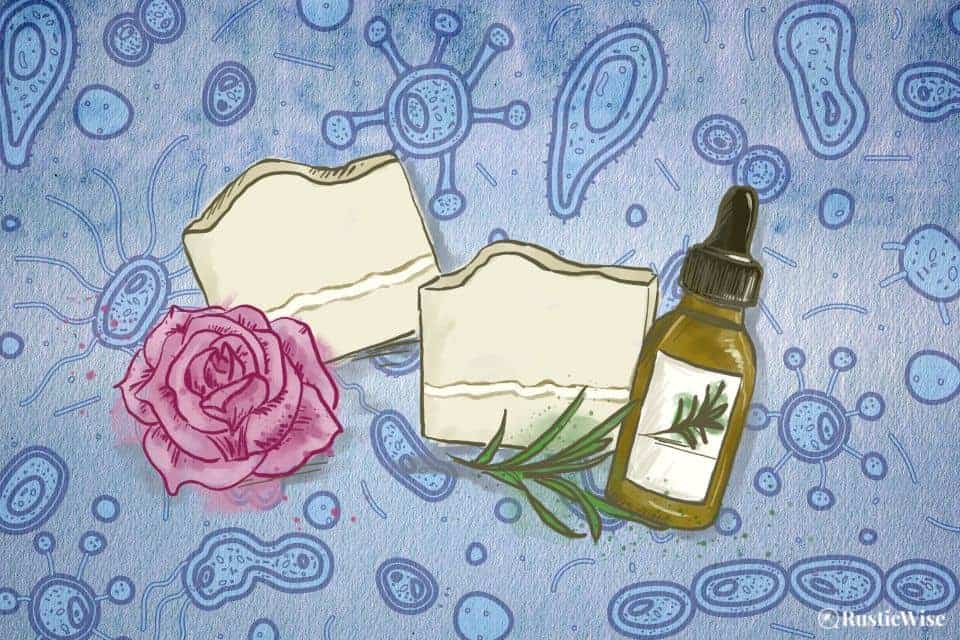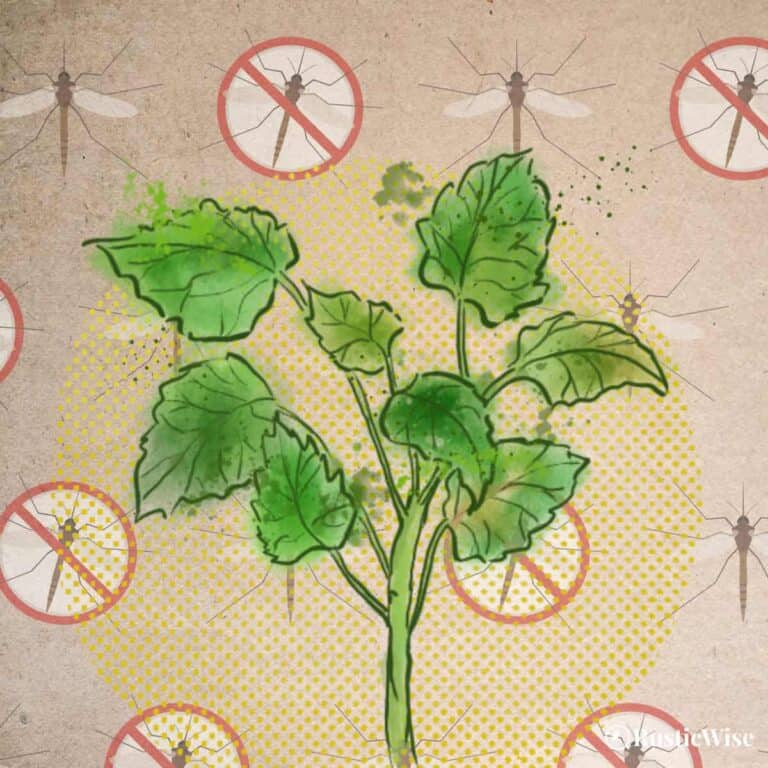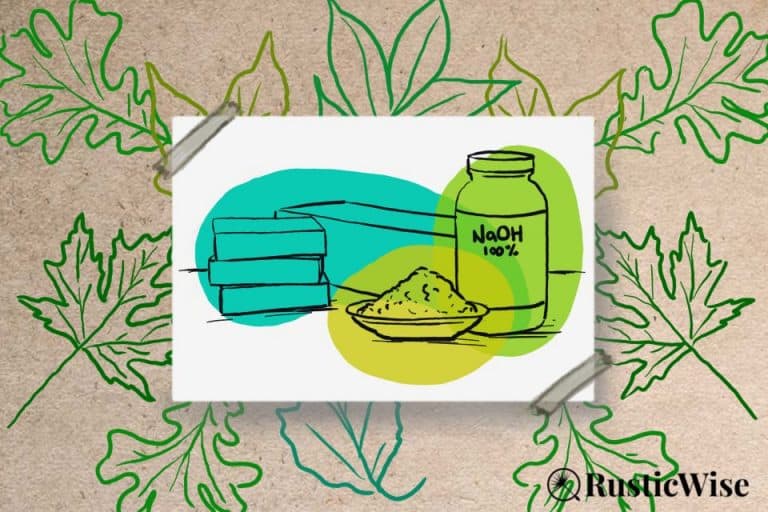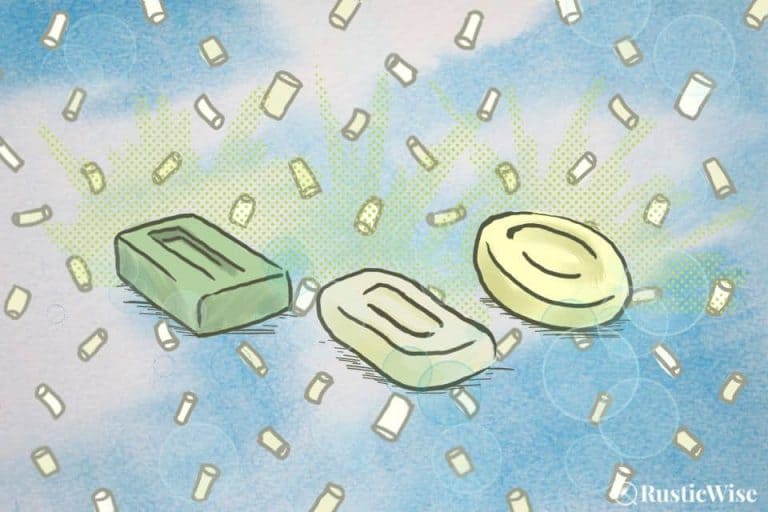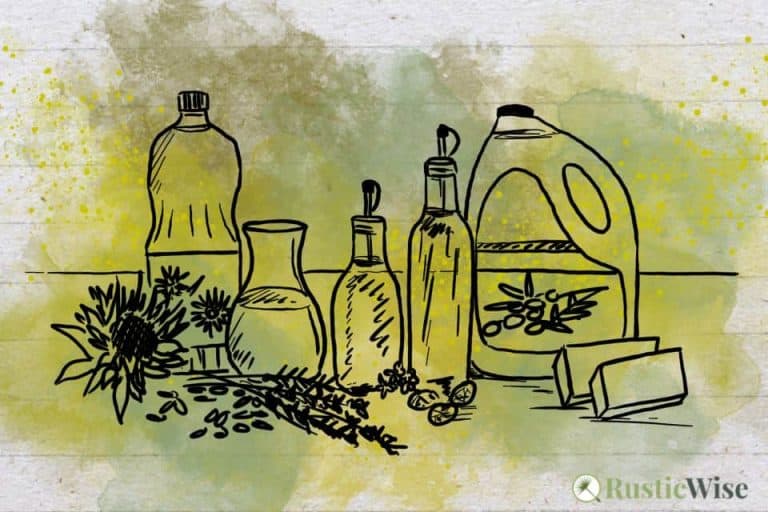Natural Antibacterial Soap: 13 Essential Oils With Cleansing Power
We often equate the term “antibacterial” with cleanliness. However, you don’t need harsh antibacterial ingredients to properly rid your skin of germs.
When we look to nature, people have used botanicals for various medicinal purposes since ancient times. Today, science has proven that many ingredients used to make natural antibacterial soap, such as essential oils and certain vegetable oils, carry antimicrobial properties.
The U.S. FDA has banned several chemical ingredients found in household antibacterial products (namely triclosan and triclocarban) since 2016. Why? Because “antibacterial” products made with these chemicals were not more effective than regular soap.
Let’s take a closer look at what ingredients in nature carry antimicrobial qualities, and whether you really need antibacterial soap.
Are all soaps antibacterial?
Simply put, no, not all soaps are antibacterial.
The definition of antibacterial, according to the Cambridge Dictionary applies to something that is “intended to kill or reduce the harmful effects of bacteria especially when used on the skin.”
Technically, regular liquid soaps or bar soaps don’t meet this definition. While plain soap helps remove bacteria from hands and skin, and can help prevent the spread of germs, it does NOT actively kill bacteria.
What’s the difference between antibacterial and antimicrobial?
These two commonly used and confused terms are similar, but have key differences. The term antimicrobial encompasses a broader range of microbes. Antibacterial products only kill bacteria.¹
Antimicrobial ingredients can have antibacterial properties and work against:
- Algae
- Bacteria
- Mold and mildew
- Some viruses
- Some fungi
The takeaway: Antimicrobial is a broad umbrella term that encompasses many microbes, including bacteria. Antibacterial only applies to bacteria.

Credit: Vector State
Do you really need antibacterial soap to get clean?
If anyone knows a thing or two about handwashing, it’s the U.S. Centers for Disease Control and Prevention (CDC).
According to the CDC, plain soap works just fine to remove germs. No antibacterial soap needed. This is in line with the FDA’s ban of 19 ingredients (namely the active ingredient triclosan) found in common antibacterial cleaning products.²
The FDA banned these ingredients in 2016, as it did not find them to be more effective than soaps without these antibacterial agents. (This ban applies to everyday consumer products, however, some healthcare sanitizers or cleaning products may still use triclosan.)²
The mechanical rubbing of your hands with soap for at least 20 to 30 seconds effectively rids your skin of most bacteria. This includes washing all surface areas of your hands, including under your nails!
So how does soap work to clean hands?
Regular soap works as a surfactant to reduce the surface tension and allow dirt, oil, and microbes to be more easily washed away with water. Sing the birthday song twice and rinse clean.
Follow up with drying hands on a clean towel, or air-drying. It’s important to dry hands thoroughly, as it appears germs are more easily transferred onto wet hands.
Is antibacterial soap good for your skin?
Triclosan, as we just examined, isn’t necessary to get clean. It may also pose issues for your long-term health and the environment.
The Environmental Working Group (EWG) recommends avoiding products with the antibacterial ingredients triclosan and triclocarban (which you can find in deodorant, toothpaste, and some industrial cleaners).
Various studies link these ingredients to disruption of the endocrine system in animal studies; it affects healthy thyroid functioning, which is needed to regulate reproductive hormones. More studies are needed to confirm this in human subjects, but this is a red flag.³
There’s also reason to believe that widespread use of common antibacterial products may lead to antibiotic and antibacterial resistance. The World Health Organization (WHO) says, “The main drivers of antimicrobial resistance include the misuse and overuse of antimicrobials…”, lack of clean water and sanitation, amongst other factors.⁴
Bacterial resistance is a global concern according to the WHO:
“Antimicrobial Resistance (AMR) occurs when bacteria, viruses, fungi and parasites change over time and no longer respond to medicines making infections harder to treat and increasing the risk of disease spread, severe illness and death.”⁴
Besides human health, triclosan is also a toxic contaminant when it enters waterways. It’s toxic to aquatic animals.
The takeaway: No, antibacterial soaps using triclosan, triclocarban, and other harsh chemicals are not good for your skin, long-term health, nor the environment. Besides strong antibacterial chemicals, there are other harsh surfactants present in most commercial soaps: sodium lauryl sulfate (SLS) and sodium laureth sulfate (SLES). These two chemicals may strip skin of natural healthy oils, leaving you with dry skin.
Antibacterial properties in nature backed by science
Harnessing the healing powers of plants is something that’s old as time. Long before we had modern pharmaceuticals, people looked to nature for cures to common ailments and aches.
Ancient Ayurvedic healing practitioners in India have long used medicinal plants to treat illnesses and as a preventative measure.
The father of modern medicine, Hippocrates, categorized and listed over 400 medicinal herbs and plants including basil, horehound, rue, and sage.
Plants contain many active compounds that serve a variety of purposes. Modern science backs up many of the medicinal properties derived from the essential oils, leaves, roots, stems, bark, and blossoms of various botanicals.
One 2017 study examined the antibacterial and antifungal properties of six various essential oils. Scientists tested these six EOs against various pathogenic, environmental bacteria, and fungi. They found that, “Oregano, thyme, clove and arborvitae showed very strong antibacterial activity against all tested strains at both full strength and reduced concentrations.”⁵
Another study cites various plant parts with microbial properties. Caffeic acid found in common garden herbs tarragon and thyme contain antimicrobial properties effective against bacteria, fungi, and viruses. Extracts found in woodruff (Galium odoratum) have shown general antimicrobial qualities. Basil oil has shown effectiveness in disinfecting lettuce leaves.⁶
Another 2017 study looks at the antimicrobials found in various EOs and has shown that many essential oils may be effective agents of food preservation. The active constituents in EOs, which include terpenes, terpenoids, carotenoids, coumarins, and curcumins, contain antimicrobial properties that may be used as safe and biodegradable food preservatives.⁷
A note on safety when using natural ingredients
One note of caution: just because something is natural doesn’t mean it’s completely safe. Plants, essential oils, and other natural extracts may still cause harm if misused.
Always consult with your doctor before using essential oils, especially if you are pregnant, breastfeeding, or have other underlying health issues.
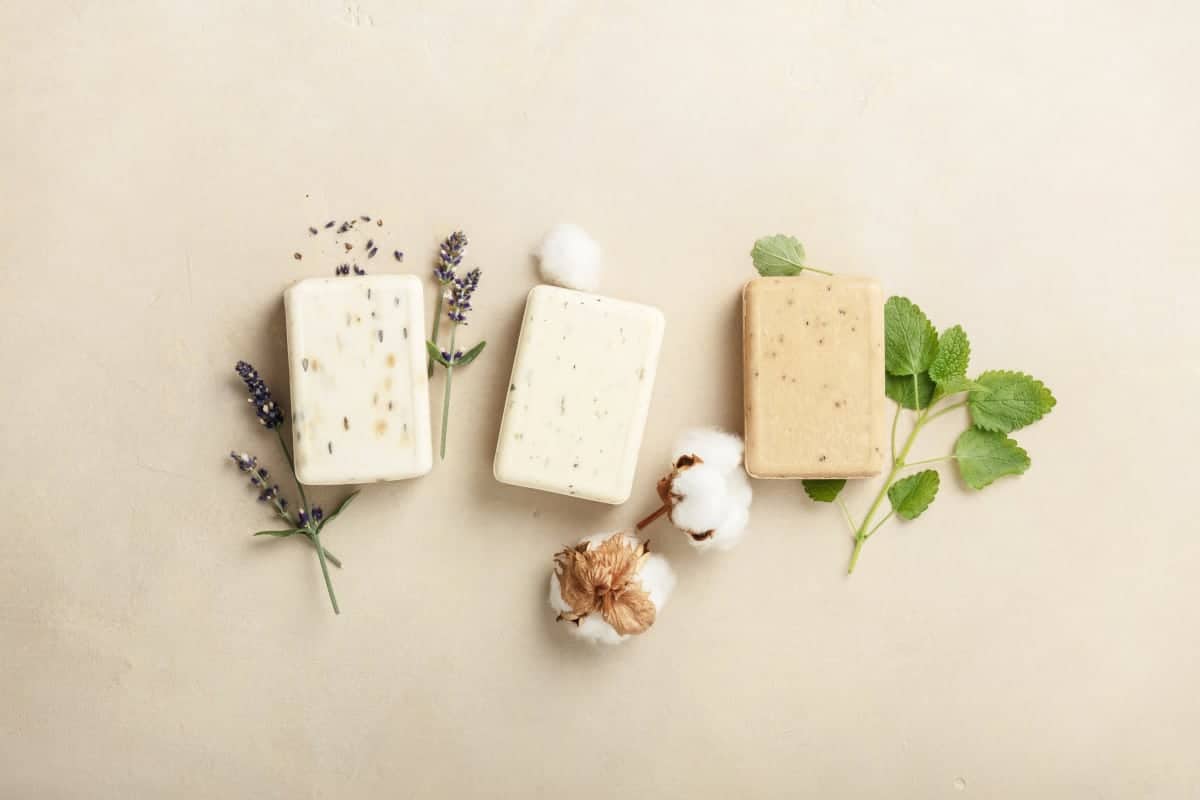
Credit: Vector State
What is natural antibacterial soap?
In a nutshell, natural antibacterial soap is simply soap made using natural vegetable oils and/or animal fats, along with other essential oils or additives that may contain antibacterial properties.
Natural soaps by definition (aka soap made by scratch) according to the FDA is, soap comprised mainly of “alkali salts of fatty acids.”
Simply put, this is soap made using the cold process or hot process method, which involves at its most basic level: distilled water + oils/fats + sodium hydroxide lye + any other EOs or additives. (Don’t worry, the lye is an essential ingredient that converts oils and fats into soap molecules. There’s no active lye in the finished soap!)
So, if you really want to get a deep clean, and you don’t have any commercial antibacterial soap (with harsh chemicals), you can use a bar of natural antibacterial soap. Or, as we said, a non-antibacterial bar of soap also works!
Natural soaps don’t contain any SLS or SLES, which makes it gentler for sensitive skin.
What ingredients make soap antibacterial?
So, what exactly makes homemade soap antibacterial? There are certain ingredients, mainly essential oils, that contain natural antibacterial components. There are also some vegetable oils that contain similar qualities.
Here’s a look at a few commonly used natural antimicrobial ingredients.
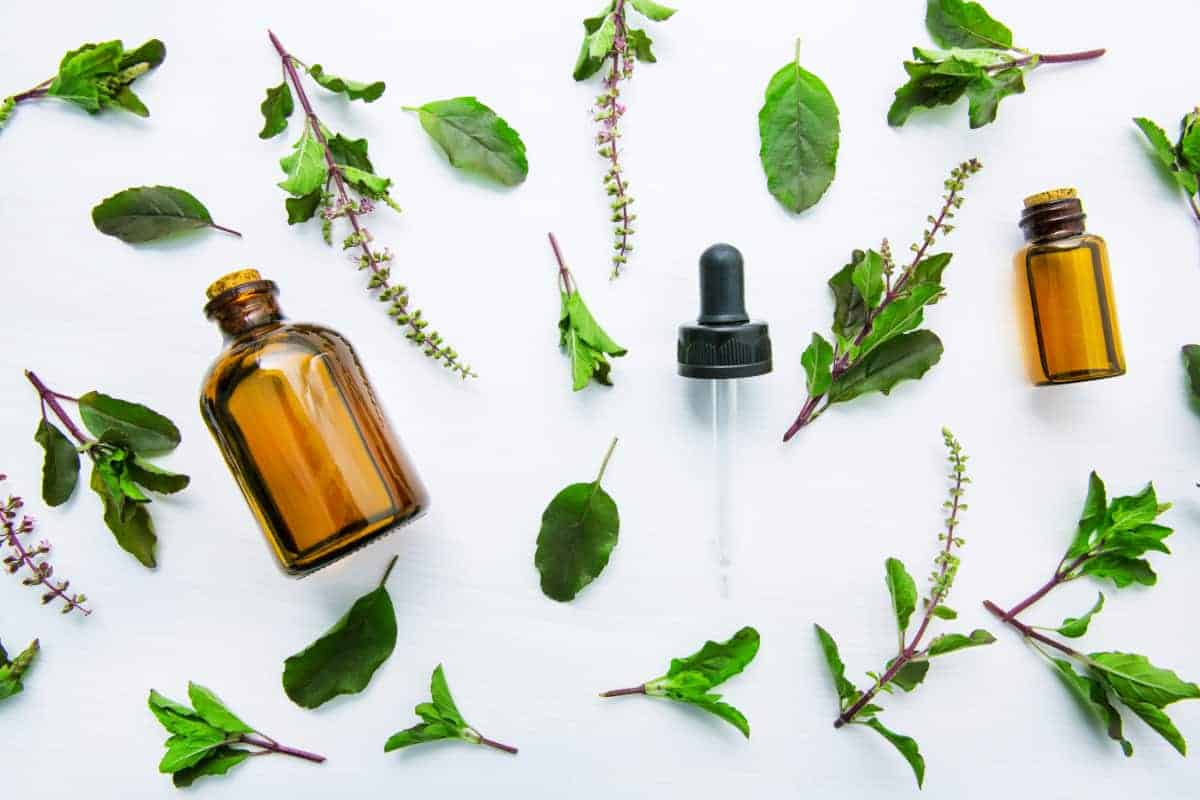
Credit: Vector State
Essential oils
Here are a few of the best antibacterial essential oils for soap:
- Basil essential oil: Sweet and fresh with a hint of spice, basil carries a woody scent, making it a strong top note. As mentioned earlier, a study shows basil contains antibacterial properties effective at disinfecting lettuce leaves against a range of bacteria.
- Clove bud essential oil: A warming and uplifting scent with spicy and sweet notes. Clove EO contains antiseptic properties.
- Eucalyptus essential oil: A popular uplifting scent that you may recognize from various cold remedies. It also helps reduce oiliness in skin. Eucalyptus contains clearing and antiseptic properties.
- Geranium essential oil: Astringent and anti-inflammatory properties with floral and herbaceous notes—it smells similar to rose. Geranium is used often topically in creams and tinctures.
- Juniper essential oil: A crisp scent that soothes irritated skin and has antiseptic properties. There are different oils that derive from juniper berries and juniper branches. Juniper berry oil is more commonly used.
- Lavender essential oil: Soothing and calming, lavender is also a great EO for treating acne and dermatitis. It contains antimicrobial and antiviral properties. Before modern antiseptics, healthcare workers used to clean hospitals with lavender.⁸
- Lemongrass and/or lemon essential oil: These citrus EOs have antiseptic properties and are good for oily skin. Pair with other citrus scents for more staying-power in cold process soap.
- Orange essential oil: Sweet orange EO is an uplifting and warming scent with powerful antibacterial properties suitable for acne-prone skin.
- Palmarosa essential oil: Distilled from grasses, palmarosa’s antibacterial properties help with acne and moisturize dry skin.
- Patchouli essential oil: A strong and distinct scent that contains skin regenerating properties. This is one EO that improves with age. It’s sometimes used as an insecticide and contains antifungal and antibacterial properties.
- Peppermint essential oil: A popular scent, peppermint is stimulating with antiseptic qualities. Use in small doses, as it may cause skin to feel tingly.
- Tea tree essential oil: Tea tree oil (aka melaleuca oil) is a perennial favorite in skincare products for its antiseptic properties and uplifting scent. It’s handy to keep a bottle of tea tree oil around the home for a variety of cleansing purposes. The Mayo Clinic says tea tree oil is effective in treating acne, athlete’s foot, dandruff, lice, nail fungus and insect bites.⁹
- Thyme (white): White thyme oil has many soothing and antibacterial properties. However, use caution when using around mucus membranes as it contains high levels of thymol, which can cause irritation.
Vegetable oils
We all know that eating a diet rich in whole vegetables ensures you get most of your daily vitamins. So perhaps it’s no surprise that vegetable oils also contain plenty of healthy vitamins, flavonoids, and antioxidants.
Many studies demonstrate that a variety of vegetable oils have antimicrobial activity and may inhibit the growth of certain strains of bacteria.
A 2018 study examined 14 popular vegetable oils found in Japan (surprisingly, olive oil was not one of them as it wasn’t readily available). The results show that cotton, grape, chia, sesame, and rice bran oils demonstrated the strongest inhibition of the growth of S. aureus and E. coli than the other oils.¹⁰
Here are some vegetable oils with antibacterial properties that could serve as good soap making oils:
Plant infusions
There are two main ways to imbue your handcrafted soap with the natural healing properties of botanicals: oil infusions, or lye water tea infusions.
With oil infusions, you draw out the nourishing properties of various plants or flowers by using a carrier oil. You can apply a bit of heat to speed up the infusion process. Lightweight oils such as olive, sunflower, and sweet almond oils work best as carrier oils.
The other method is to steep botanicals in the water you’re using to make your lye water solution (think of it like steeping a cup of tea.) This method is quicker than oil infusions.
Do any of the beneficial antibacterial properties survive the soap making process?
Now if you know a thing or two about the natural soap soap making process, you know that lye is a caustic ingredient that can gobble up many of the beneficial properties of botanicals and oils during saponification.
So do any of the beneficial properties (antibacterial or otherwise) of plants actually carry over to the finished soap? This is a hotly debated topic amongst soap makers (and an area where there is a lack of scientific studies).
While it’s true that lye and the saponification process can certainly destroy some beneficial qualities, many soap makers can attest to the fact that a batch of soap made with certain essential oils, infusions, and additives feel different than batches made without these same ingredients.
Some compounds and ingredients are more resistant to high temperatures and the rigors of soap making.
The final word on natural antibacterial soap
If you’re looking for a deep-clean, you can skip the chemical-filled antibacterial soaps. Not only do these chemical antibacterial agents pose possible long-term health risks to your body, they also harm the environment. Besides, the CDC and the FDA deem antibacterial soaps to be no more effective at cleaning than regular soaps.
Instead we can turn to nature to deliver some natural antibacterial properties in plant components. Using certain essential oils and vegetable oils with proven antimicrobial properties can be healthier for your skin and environment.
New to making soap? 🧼❓
👉We have a fantastic overview on the whole soapmaking process here: read our Timeless Guide To Soapmaking.
If you would like to see our soapmaking posts organized by topic type, see our Soapmaking Collection.

References
- Microban, Antibacterial vs. Antimicrobial, https://www.microban.com/antimicrobial-solutions/overview/antibacterial-vs-antimicrobial. Accessed March 2022.
- U.S. Centers for Disease Control and Prevention (CDC), Show Me the Science – How to Wash Your Hands, https://www.cdc.gov/handwashing/show-me-the-science-handwashing.html. Accessed March 2022.
- The Environmental Working Group (EWG), Top Tips For Safer Products, https://www.ewg.org/skindeep/contents/top-tips/. Accessed March 2022.
- World Health Organization (WHO), Antimicrobial Resistance, https://www.who.int/news-room/fact-sheets/detail/antimicrobial-resistance. Accessed March 2022.
- Puškárová, A., Bučková, M., Kraková, L. et al. The antibacterial and antifungal activity of six essential oils and their cyto/genotoxicity to human HEL 12469 cells. Sci Rep 7, 8211 (2017). https://doi.org/10.1038/s41598-017-08673-9
- Cowan M. M. (1999). Plant products as antimicrobial agents. Clinical microbiology reviews, 12(4), 564–582. https://doi.org/10.1128/CMR.12.4.564
- Pandey, A. K., Kumar, P., Singh, P., Tripathi, N. N., & Bajpai, V. K. (2017). Essential Oils: Sources of Antimicrobials and Food Preservatives. Frontiers in Microbiology, 7. https://doi.org/10.3389/fmicb.2016.02161
- Cleveland Clinic, How Lavender Can Improve Your Health, https://health.clevelandclinic.org/health-benefits-of-lavender/. Accessed March 2022.
- Mayo Clinic, Tea tree oil, https://www.mayoclinic.org/drugs-supplements-tea-tree-oil/art-20364246. Accessed March 2022.
- Xuan, T. D., Gangqiang, G., Minh, T. N., Quy, T. N., & Khanh, T. D. (2018). An Overview of Chemical Profiles, Antioxidant and Antimicrobial Activities of Commercial Vegetable Edible Oils Marketed in Japan. Foods (Basel, Switzerland), 7(2), 21. https://doi.org/10.3390/foods7020021
- Nevin, K. G., & Rajamohan, T. (2010). Effect of topical application of virgin coconut oil on skin components and antioxidant status during dermal wound healing in young rats. Skin pharmacology and physiology, 23(6), 290–297. https://doi.org/10.1159/000313516
- S Cicerale, LJ Lucas, RSJ Keast, Antimicrobial, antioxidant and anti-inflammatory phenolic activities in extra virgin olive oil, Current Opinion in Biotechnology, Volume 23, Issue 2, 2012,Pages 129-135,ISSN 0958-1669, https://doi.org/10.1016/j.copbio.2011.09.006.

Author: Theresa Tesolin
Theresa is co-founder of RusticWise. She helps people unleash their inner DIY spirit by encouraging them to get dirty and make or grow something from scratch.

